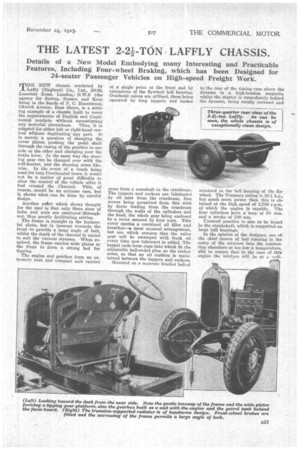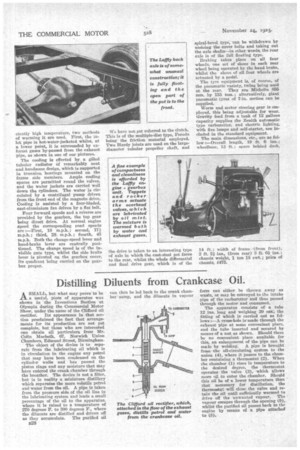THE LATEST 2-21-ToN LAFFLY CHASSIS.
Page 11

Page 12

If you've noticed an error in this article please click here to report it so we can fix it.
Details of a New Model Embodying many Interesting and Practicable Features, Including Four-wheel Braking, which has been Designed for 24-seater Passenger Vehicles on High-speed Freight Work.
MHE NEW chassis marketed by
Laffly (England) Co., Ltd., 20-26, Lonsdale Road, London,, N.W.6 (the agency for Surrey, Sussex, and Kent being in the hands of P. C. Beardwootl, Church Avenue, East Sheen, is a striking example of a chassis built to cover the requirements of English and Continental markets iwithout necessitating
any material alterations. Thus, it is adapted for either left or right-hand control without duplicating any 'part. it is merely a question of changing the cover plates, pushing the pedal shaft through the casing of the gearbox to one side or the other and changing over the brake lever. In the same way the steering gear can be changed over with the self-starter, and the steering arms likewise. In the event of a coach being used for long Continental tours, it would not be a matter of great difficulty to alter the control of the vehicle after it had crossed the Channel. This, of course, would be an extreme case, but it shows what can be done by careful design.
Another point which shows thought for the user is that only three sizes of bolts and nuts are employed throughout, thus greatly facilitating service.
The frame is straight in the horizontal plane, but is inswept towards the front to provide a large angle of lock, whilst the depth of the channel is varied to suit the various stresses. When required, the frame carries wide plates at the front to form a strong bed for tipping.
The engine and gearbox form an extremely neat and compact unit carried at a single point at the front and by extensions of the flywheel bell housing. Overhead valves are utilized, these being operated by long tappets and rocker
arms from 4 camshaft in the crankcase. The tappets and rockers are lubricated by oil mist from the crankcase, free access being permitted from this mist by ducts leading from the crankcase through the walls of the cylinders and the head, the whole gear being enclosed by a cover secured by four nuts. This cover carries a combined oil filler t‘nd breather--ft most unusual arrangement, but one which ensures that the valve gear will be swamped with fresh oil every time new lubricant is added. The tappet ends form cups into which fit the adjustable ball-ended pins on the rocker arms, so that an oil cushion is maintained between the tappets and rockers.
Mounted on a separate bracket bolted to the rear of the timing case above the dynamo is a high-tension magneto, whilst the starter is immediately behind the dynamo, being totally enclosed and mounted in the bell housing of the flywheel. The Treasury rating is 20.1 h.p., but much more power than this is obtained at the high speed of 2,700 r.p.m. of which the engine is capable, The four cylinders have a bore of DO mm. and a stroke of 130 mm.
Unusual practice is also to be found in the crankshaft, which is supported on large ball bearings.
In the opinion of the designer, one of the chief causes of bad running is the entry of the mixture into the combustion chambers at too low a temperature, and to ensure that in the case of this engine the mixture will be at a eiiffi.. cieutly high temperature, two methods of warming it are used. First, the inlet pipe is hot-water-jacketed whilst, at a lower point, it is surrounded by exhaust gases by-passed from the exhaust pipe, as shown in one of our pictures.
The cooling is effected by a gilled tubular radiator Of remarkably neat and handsome design, which is supported in trunnion, hearings mounted on the frame side members. Ample cooling spaces are permitted round the valves, and the water jackets are carried well down the cylinders. The water is circulated by a centrifugal pump driven from the front end of the magneto drive. Cooling is assisted by a four-bladed, east-aluminium fan driven by a flat belt.
Four forward speeds and a reverse are provided by the gearbox, the top gear being direct drive. At normal engine speed the corresponding road speeds are :—First, 10 m.p.h.: second, 17i m.p.h.; third, 28 m.p.h.; fourth, 45 m.p.h. Both the change-speed lever and hand-brake lever are centrally positioned. The change speed is of the invisible gate type, whilst the side brake lever is pivoted on the gearbox cover, its quadrant being carried on the gearbox proper. We have not yet referred to the clutch, This is of the multiple-disc type, Ferodo being the friction material employed. Two Hardy joints are used on the large diameter tubular propeller shaft, and the drive is taken to an interesting type of axle in which the cast-steel pot faces to the rear, whilst the whole differentia/ and final drive gear, which is of the spiral-bevel type, can be withdrawn by undoing the cover bolts and taking out the axle shafts—in other words, the rear axle is of the full floating type.
Braking takes place on all four wheels, one set of shoes in each rear wheel being operated by the hand brake, whilst the shoes of all four wheels are actuated by a pedal.
The tyre equipment is, of course, of the pneumatic variety, twins being used at the rear. They are Michelin 855 ram. by 155 mm. alternatively, giant pneumatic tyres of 7-in. section can be supplied.
Worm and sector steering gear is employed, this being adjustable for wear. Gravity feed from a tank of 12 gallons capacity supplies the Zenith automatic type carburetter, and electric lighting„ with five lamps and self-starter, are included in the standard equipment.
The main dimensions, etc., are as follow :—Overall length, 10 ft. 6 ins.; wheelbase, 13 ft.; space behind dash,
14 ft.; width of frame (from front), 2 ft. 2A• ins., (from rear) 3 ft. 6,1 ins.; chassis weight, 1 ton IS cwt.; price of chassis, £475.




































